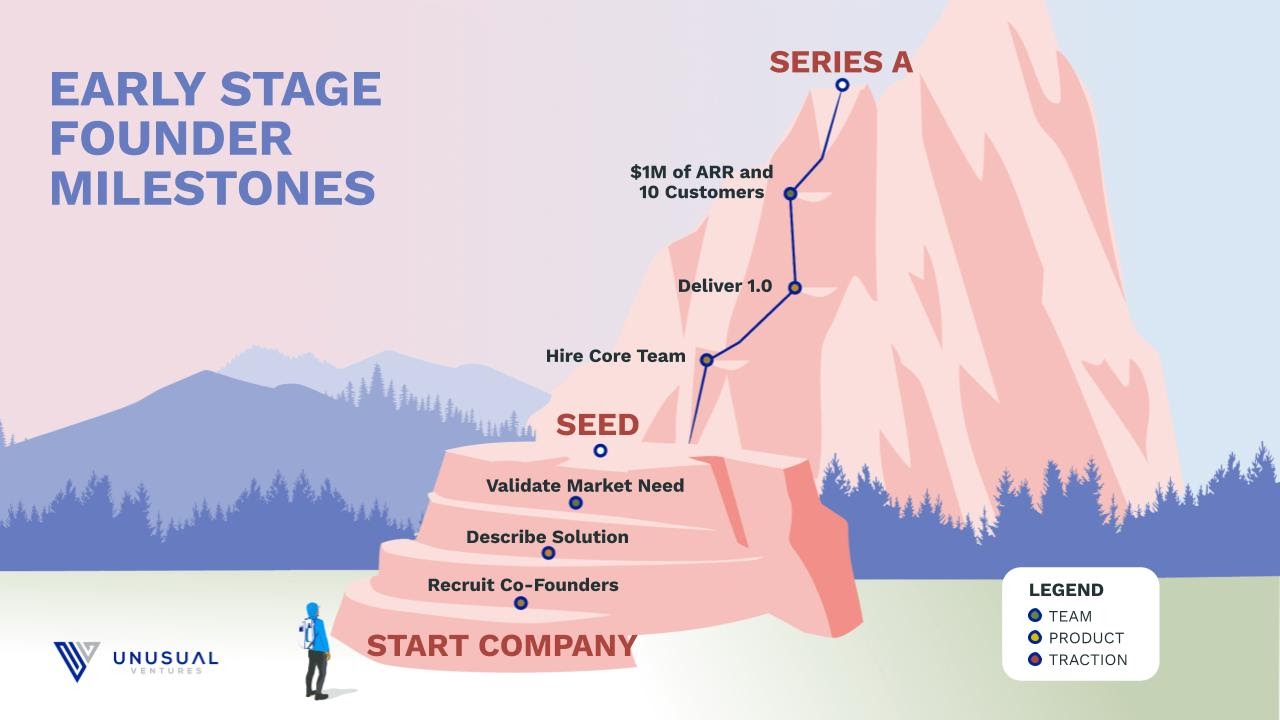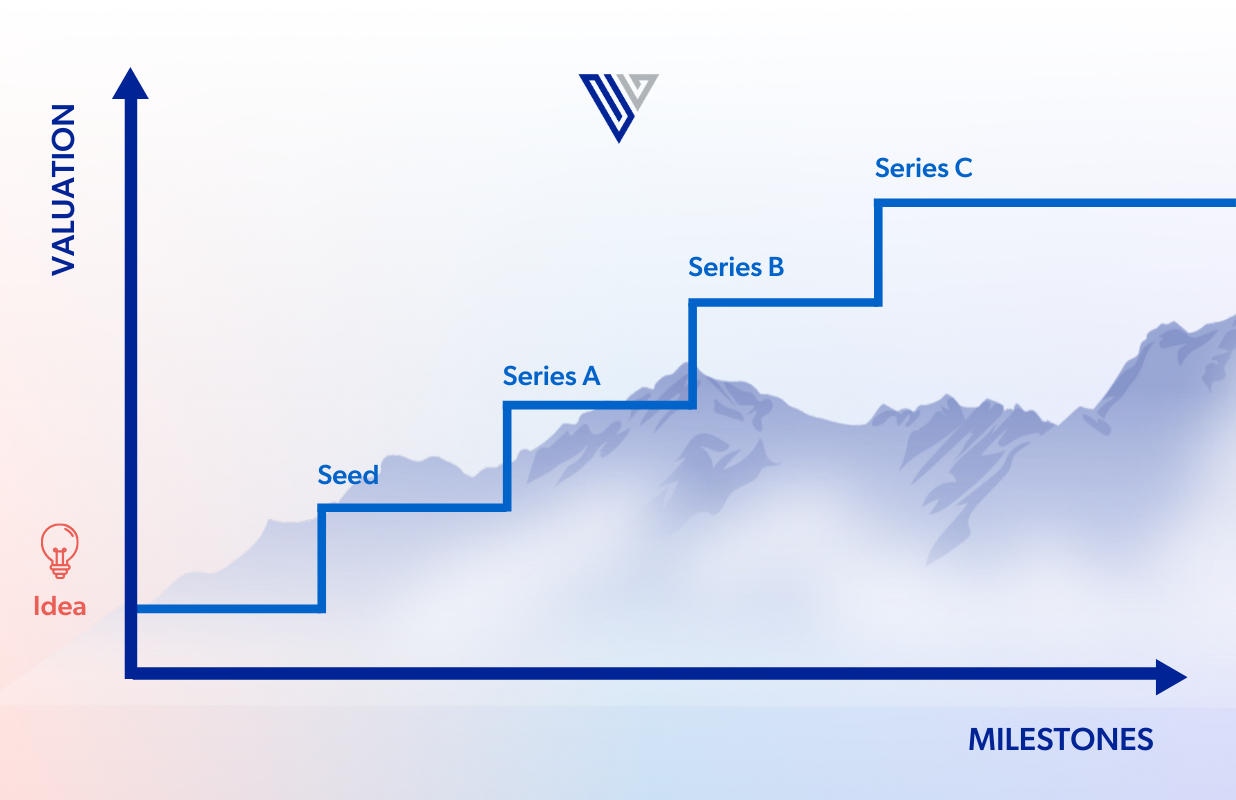
.png)
As a founder, you’ve embraced the life-changing decision to set out and tackle the difficult obstacles on the way to building a valuable, enduring company. At Unusual, we decode the lessons of the masters and make them available to tomorrow’s founders to increase their likelihood of success.
In this module, we’ve broken down our early-stage fundraising guide into two basic parts: Part I. Milestones and Valuations for Seed and Series A, and Part II. Approaching Investors, The Pitch, and Closing the Deal. This guide is tailored to Founders of Enterprise Software companies. (We will cover Consumer milestones in a separate post, but there may still be relevant learnings for Consumer Founders.)

As an entrepreneur, thinking about all that needs to happen to succeed can be overwhelming. Many successful founders joke, “If I knew how hard starting a company would be, I’m not sure I would have taken the leap!” At Unusual Ventures, through our time spent with hundreds of successful entrepreneurs, we’ve learned that the vast majority break the larger journey into smaller, more manageable phases—each with specific goals. It may be a management secret, or possibly just a coping mechanism, but either way, it works. Conveniently, the phases are typically bookended by fundraising events. The simple formula is:
In the early years of a startup, we believe there are three distinct phases for founders to successfully navigate: the Idea Phase, the Seed Phase, and the Series A Phase. Each phase has distinct goals along three dimensions: Team, Product, and Traction.
This is the period when a founder is seriously contemplating taking the leap to start a new company.
The milestones in this phase are consistently:
A) Team – recruiting a co-founder
B) Product – creating a detailed description of the solution to build
C) Traction – talking with enough customer prospect types to confirm the “founding insight” that there is a true market pain and now is the time to solve it
Oftentimes, founders quit their current job to focus on accomplishing these milestones, but that is not always the case. It is true that sometimes founders do A, B, and C before quitting their job and/or incorporating a new company. Both can work. The key point: Order of operations is not critical at the Idea Phase!
If these milestones are achieved, and the business is a fit for venture capital, it is at this point that the company would seek to raise Seed capital.
A note on “founding insight”: This is your bedrock intuition that you are building your company on. Ideally, you’ve had first-hand experience living the pain that drives your belief that now is the time to build a new solution. Critically important in the Idea Phase is validating this belief through at least 20-30 customer prospect conversations. (See more specific tactics in our Outreach Playbook).
Note: We interchange “Seed” and “Pre-Seed” to mean the first invested capital in a startup. Raising seed investment is for Idea Stage companies that are Pre-Product Market Fit.
As Benchmark Capital founder and Stanford Business school professor Andy Rachleff teaches in our Unusual Academy, achieving Product Market Fit (PMF) means that a startup has proven it understands which features to build, for a specific audience that cares desperately, with a business model that drives customer purchases. The primary goal of the Seed Phase is to find and demonstrate Product Market Fit.
The milestones to accomplish in the Seed Phase are:
A) Team – hiring the core team
B) Product – delivering 1.0 of the product
C) Traction – reaching a traction level where the business has 10+ customers and $1M of ARR
10+ customers and $1M of ARR are not exact figures, but approximately what Series A investors look for in 2020. Note that traction is not 10 customers or $1M. Typically, you’re not looking for a single large elephant or two. Having a mix of a few six-figure customers and small-mid size customers in the $50K ARR range demonstrates repeatability and flexibility of your early go-to-market strategy.
If these milestones are achieved, it is at this point that the company would seek to raise Series A capital.
This is the period when the startup scales its go-to-market efforts to accelerate revenue based on demonstrated Product Market Fit.
The milestones to accomplish in the period after raising a Series A are:
A) Team – primarily increasing sales and marketing headcount
B) Product – building 2.0 of the product based on vision and market feedback, while removing early technical debt
C) Traction – reaching 50 customers and ~$10M of ARR

For private companies, valuation increases occur at the time of fundraising. It’s essential that founders understand the following facts:
Understanding that startups increase in value once key milestones are achieved enables founders to focus on creating a specific set of goals at each stage of the company’s journey. This way of thinking is one of the foundational pillars of the Unusual Method.
Founders should appreciate that there is no “partial credit” in the startup journey. Achieve the milestones and de-risk the business such that more capital can be raised—or fail. Or, as we like to say at Unusual,
“Getting 80% of the way to the moon doesn’t count for anything.”
For Seed and Series A enterprise companies, the good news for founders is that the line for what milestones need to be achieved at each stage is clear.
Once the right goals have been set, what’s left is the fundraising process itself. This process can be broken down into five basic questions: